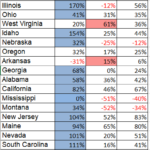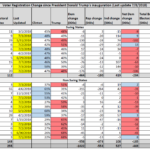Politically, the 2018 election season is in “half time” right now: as of June 26, 30 states have held their primaries, and primary season doesn’t resume until the Tennessee primary on August 2 (although there are party runoffs in Alabama and Georgia over the next two weeks). There has recently been talk about the Democratic partisan wave receding (and Republicans gaining steam). Is this talk based on factual information, or is it partisan cheerleading? To assess what is actually happening, JMC will return to the same four metrics that were used in a previous analysis written six months ago:
- Partisan enthusiasm,
- Voter registration changes,
- Interim election results, and
- The political climate.
Factor One: Partisan Enthusiasm
Midterm election turnout is always lower than it is in Presidential election years, which therefore elevates the importance of base/partisan enthusiasm (especially in close races). JMC believes that before the fall elections, partisan enthusiasm can be measured in advance during primary season, provided that both parties have contested primaries for a statewide office like Governor or U.S. Senator.
Of the 30 states that have held primaries so far, 20 of them had measurable statewide partisan turnout at the top of the ticket, and in those 20 states, 57% voted in the Republican primary in 2014 (15.3 million overall primary turnout). This year, 54% have voted in the Democratic primary (22.1 million overall primary turnout). In other words, Democratic turnout increased 79% relative to the 2014 primaries, while Republican turnout increased 18% (overall primary turnout is 44% higher than it was in 2014).
Change in partisan turnout between 2014 and 2018
Factor Two: Voter registration changes
Another metric JMC uses to measure partisan enthusiasm is an examination of changes in party registration in states where there is voter registration by political party, since in a partisan wave, more people would choose to register as Democrat or Republican, particularly if the date President Trump was inaugurated (January 20, 2017) was used as the starting date. Curiously, while primary turnout clearly shows a surge in Democratic enthusiasm, there is no discernible evidence (from a party registration perspective) of a Democratic wave. More specifically, since January 2017, there are 1.022 million less Democratic voters, 553K less Republican voters, but 527K MORE unaffiliated/third party/Independent voters over a denominator of 93 million registered voters in 23 states.
Factor Three: Interim election results
Where Democrats have had reason to feel confident is from their performance in interim/special elections held since January 2017. Not only did they sweep the two governor’s races (New Jersey and Virginia) last fall, but they also scored an upset win in the Alabama Senate race, and there have been several dozen pickups in legislative races. Furthermore, in eight Congressional special elections held since Trump’s inauguration in Republican districts, Republican candidates have generally underperformed relative to Donald Trump’s showings in those same districts. Why does this matter? There are 42 House Republicans (the margin of control, and then some) sitting in districts where President Trump received less than 50% of the vote, while only 4 Democrats sit in districts where Trump received a majority of the vote. In an era of mostly straight ticket voting, that one statistic should concern Republicans.
Factor Four: Political climate
Politics is a business/sport (depending on your perspective) that thrives on perception. And with the perception that this will be a good year for Democrats, Democrats are facing a surge of enthusiasm at the candidate recruitment level. More specifically, candidate filing for Congressional races has concluded in 49 states (candidate filing in Louisiana is next week), and of 235 Republican held seats, 232 (or 99%) face Democratic opponents, while of 194 Democratic held seats, 156 (or 80%) face Republican opponents. The fact that only three Republicans escaped Democratic opposition clearly shows that Democrats are aggressively recruiting challengers, and more challengers are willing to run than they would have in previous election cycles.
Closely related are Congressional retirements. If there is an overwhelming number of Congressional retirements coming from one party or another, that indicates a lack of confidence in party’s chances in the fall elections. And according to the U.S. House, 50 House Republicans and 22 Democrats are not coming back next year. To put these numbers in perspective, a turnover of 50 House Republicans is the highest it’s been in decades.
Conclusion
While the political climate, interim election results, and partisan enthusiasm have favored the Democrats thus far, voter registration changes throughout last year haven’t shown a perceptible shift towards the Democrats. So while the climate looks nearly as favorable for the Democrats as it did in 2006 or 2008, the ultimate result depends on party turnout on Election Day.


